One of the essential parts of buying antique silver is the identification of silver marks. Silver marks are important ways of deciding the purity of the silver, the company name of the manufacturer, and other information like the metal content of the silver.
If you want to buy sterling silver, Vintage silver, or pure silver, you need to get good at identifying date marks, makers marks, and other marks found that indicate that the silver is of sterling quality.
This article is a guide to help you identify the different types of silver marks on silver pieces, so you can make an informed decision when buying or selling silver items.
Table of Contents
What Is Identification Silver Marks?
Have you ever thought about those words, digits, or symbols engraved on silver pieces passed down in your family?
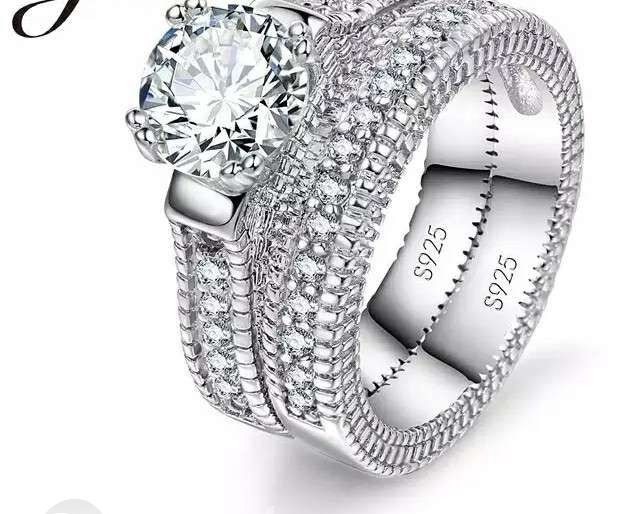
Maybe you have a piece of silver jewelry in your house that is worth a lot, but you don’t know what to do with it because you don’t understand what it means. Well, now is the time for you to understand what silver hallmarks are.
Silver hallmarks or marks found on silver pieces are engravements on silver flatware, jewelry, or other silver-plated items that indicate the value of a piece of silver.
These marks often show the quality of the silver and other important details about when it was struck and who struck it. They also indicate if a silver piece is of high quality (sterling silver) or low quality, like electroplated silver, Venetian silver, or silver-plated metal alloys.
Since as early as the 16th and 17th centuries, countries and territories have created silver hallmarks on their silver pieces to separate them from other territories, at the same time, manufacturers have put their standard mark to prove the superiority of their silver.
Luckily for us, these symbols, signs, digits, and letters have made it easy for us to accurately date pieces of this precious metal. Using the silver hallmark of metal, you can tell how much that metal is worth and if you should bother looking for a buyer.
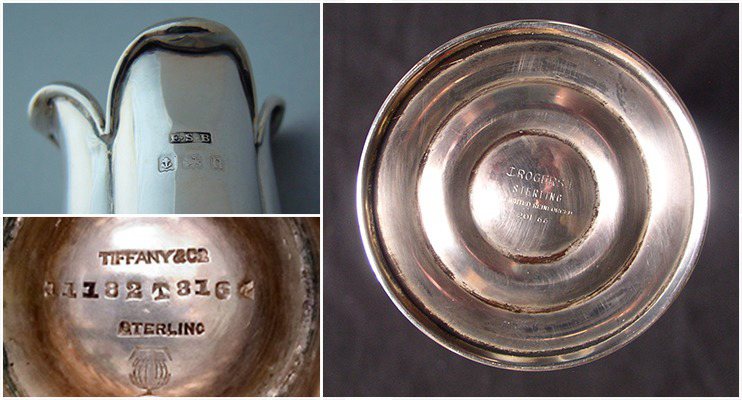
Depending on the hallmark, it could be one type of silver or another. The hallmark might also show that a piece of metal is not silver but alloys of other metals with a silvery look and feel.
This way, you can know how to deal with those antiques you have stored in your room forever. For example, if your silver piece is worth some good money, you can decide to pawn it off or keep it to appreciate.
We will examine different silver markings and their meaning on these precious metals.
Identifying the most Popular Silver Markings
Today, you can find different kinds of old and new silver in the market. Each one has its mark that distinguishes it from others.
Identification of a silver mark on silver-plated items is easy. Here are a few steps to follow to identify the marks on your precious metals today.
Step 1 – Find Where the Hallmark Is on the Piece of Silver
The first step is to find where the hallmark is stamped on the silver piece. Usually, people have problems finding the marked portion of the metal because of the age of said metal. The solution is to use your fingers to rub the surface of the metal and feel for indentation.
If the mark is rubbed, breathe on it to make it clearer.
As soon as you can identify the marks on the silver flatware or jewelry, you can start to decipher where it comes from, its level of purity, and other vital details about the metal.
Step 2 – Look for the Standard Mark
The standard mark helps you identify if your silver is real or silver-plated. Without this mark, you cannot determine if the piece of metal you have in your hand is real silver or fake.
Different standard marks are found on a silver piece that distinguishes it from others. For example, you should see a lion passant on a piece of British sterling silver. On German silver, there should be a crescent moon.
If you cannot ascertain the authenticity of the silver piece in front of you, then the journey of identification has come to an abrupt end.
Of course, there are silver pieces without a standard mark, but these are very rare. More often than not, they’ll have a standard mark.
Apart from showing the authenticity of the piece of silver, the standard mark shows you the origin of the metal (the territory the metal came from).
Step 3: Look for the Town Mark
The town mark is a silver hallmark that shows the town the silver piece was struck. This is often found on British sterling silver pieces.
There are different marks for different towns in the UK where the piece could have been struck. For example, London is represented with a leopard head. If you aren’t sure what town the mark on your piece represents, you can look for help online.
Correctly identifying the town mark will help you know the guide to use to get further information about the silver piece. For example, if you see a London mark, you can check for more information on London guides and know more about your silver piece.
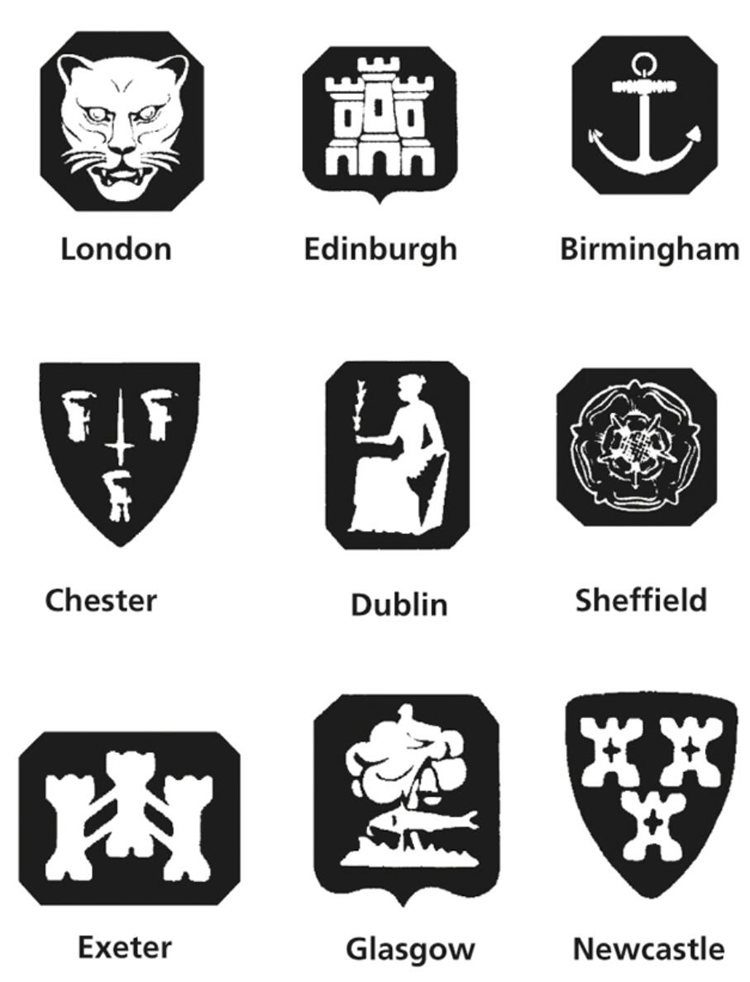
Step 4: Look for the Date Letter
The date letter is a letter or symbol used to denote the year of creation of a silver piece. Different letters mean different years, depending on the country or territory where the silver piece was struck.
For example, if you see “1A” on a piece of Danish Silver, it means the silver piece was struck in 1759.
It is crucial to get this hallmark right because the year a piece is struck could affect the quality of the silver. For example, all American coin silver pieces made between 1792 to 1837 have an 89.2 percent purity. Coins after that have a 90 percent purity.
Many online guides can help you with the year if you are confused about the date letter.
Step 5: Look for the Maker’s Mark
The maker’s mark is another vital hallmark that helps you identify the manufacturer of the silver piece.
The manufacturer of an antique silver piece could use their symbol or initials as silver markings on the piece to make it recognizable. Look for these initials and use online guides to check their meaning.
Armed with the knowledge of the year, town, and manufacturer of the silver piece in your hand, you can make informed decisions to sell or value it at the right price.
In addition, a sterling silver piece could contain silver hallmarks that show the amount of silver contained within it. For example, you could see numbers like .925 or 925/1000, indicating that the piece contains 92.5% silver, among other alloys.
Examples of Common Stamps on Silver You Should Know About
Let us go through a few examples of some of the most popular silver pieces and their unique marks.
American Silver Marks (coin)
One of the most important examples of American silver is coin silver. A coin contains up to 89.2 percent of silver if it was made between 1792 to 1837. The US Mint set this number in ancient times after the American revolution.
Later, after 1837, the value of the coin silver increased to 90 percent.
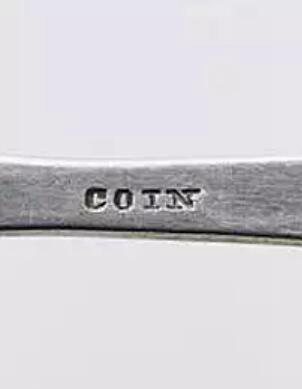
On every American coin, you will find the maker’s mark, the standard mark, and the date stamp.
American marks can also be found on jewelry. Most of them are simply marked with a letter showing the manufacturer and a number showing the standard mark or silver content.
British Sterling Silver
Sterling silver is one of the most important precious metals in the world. They are a kind of American silver mark after America started using the sterling standard mark.
They are also called British sterling silver because of the role of the British in introducing the world to it in ancient times.
Sterling silver has easy-to-read silver hallmarks. They have a 92.5 percent silver content, along with other metal content, like copper. On the body, you will see 925 or 925/1000, denoting the purity of the silver.
Sterling silver also has a date stamp showing when it was manufactured. Sterling pieces have unique marks that differ from one to another, so you might want to give an expert study the mark just to be 100% sure it is sterling standard.
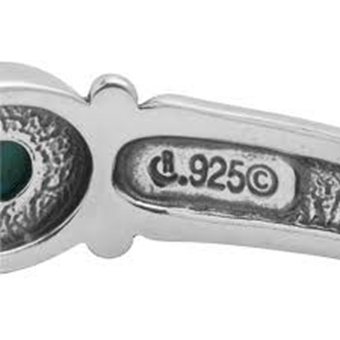
UK/Ireland Silver
Compared to the UK, American silver is new silver. British hallmarks have existed since as early as the 17th century and continued after George III became king of the UK.
UK’s sterling silver hallmarks include the Lion passant, the standard mark for the purity of the silver. Apart from the Lion passant, there is a symbol indicating Britannia purity.
UK and Ireland silver pieces also have the assay mark, town mark, maker’s mark, leopard with a crown, and date letter.
The assay mark is an indication from an assayer’s office to show that the metal has been tested pure. The date letter shows the exact year the piece was made.
The town mark was used to indicate the town the piece was struck, but it no longer exists. This is because the new law gives assay offices the right to strike silver hallmarks outside UK territory.
The maker’s mark shows who the manufacturer is, and the leopard with a crown on its head symbolizes the London Assayer’s office.
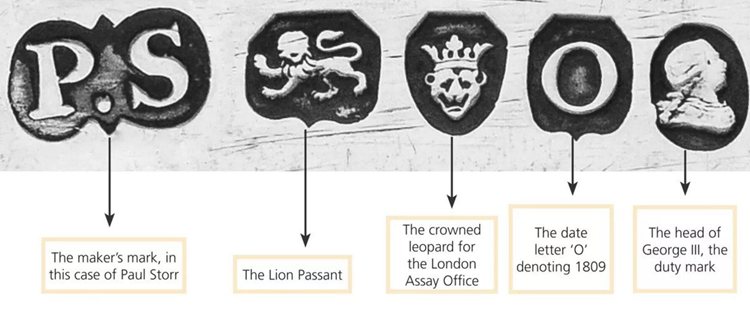
German Silver
German silver is a precious metal with a minimum solid silver content of 80 percent pure silver and other alloys like copper as the base metal. This piece of silver can sometimes be as high as the sterling silver standard or higher.
Silver plate marks on Germany’s silver could read 800, 830, 835, 900, 925, or 935. In addition, on silver flatware from Germany, you would find a silver-plated crescent moon as an identification mark.

Electroplated Nickel Silver
Electroplated Nickel silver, also known as EPNS, EPN silver, or just nickel silver, is not a pure piece of silver or silver alloy. They are made up of nickel alloys and other metal content like zinc and copper. EPNS looks like silver, so they could be deceiving.
However, they have their hallmarks. For example, on EPN silver, the manufacturer’s name is marked, along with the nickel content. Some of them have “EPNS” hallmarks on their surface too.
Be careful to check well before adding it to your antiques or jewelry collection.
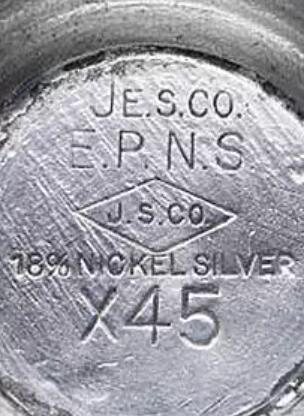
Sterling Inlaid
Sterling inlaid is another type of deceptive metal that looks like sterling silver with sterling silver hallmarks but is not pure silver. It has a mark on its surface that says “Sterling inlaid,” so be sure to look closely for it.
This kind of silver is not sterling silver. Instead, it is a silver plate laid over another base metal, like nickel. In other words, you aren’t getting 92.5 percent of silver; you are getting a silver-plated metal.
If you don’t mind much, you can use it for your jewelry, but avoid adding it to your antiques. There are also many flatware pieces that you could use inlaid silver.
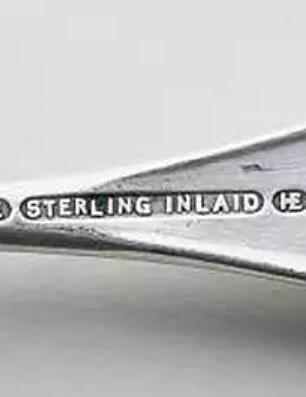
Danish Sterling Silver
Danish Sterling Silver is one of the most valuable antique silver products ever made. However, they are made with sterling quality, and their silver hallmarks are not very straightforward.
Danish silver hallmarks originally started with 82.6 percent quality before it was increased to 83.0 and eventually 92.5 percent sterling silver. The earliest method to recognize a danish silver piece was the three towers stamped on the surface.
Other Danish silver hallmarks include the year marks and the maker’s mark.
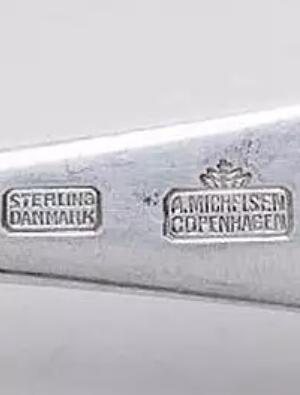
French Silver
French silver became popular after the 18th century and used simple hallmarks for its representation. It is a fine piece of antique silver with high sterling value. Most french silver pieces had a fineness from between 80.0 to 92.5 percent.
French silver marks are easily distinguishable from other silver marks. For example, a square or rectangular cartouche shows the maker’s name, the figure shows the percentage of silver contained, and the word “DOUBLE” or “PLAQUE.”
The maker’s mark is sometimes represented in a lozenge or diamond shape.
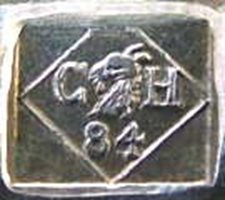
Venetian Silver
Venetian Silver is a proprietary name given to a base metal alloy. It is not pure silver of high quality like sterling silver. It is just an alloy of silver that contains nickel and silver.
They have reduced value, like electroplated silver. Unfortunately, your silver hallmarks aren’t worth much if you have Venetian silver. Silver is not the base metal in this metal piece but acts as a surface to give it a shiny look.
If you are in the market to buy some antique silver, don’t let these kinds fool you. They are not worth much and should be treated like regular metal.
That said, they have their markings that show they are just Venetian silver. Most of them have the words “Venetian silver” and other symbols of standard British silver.
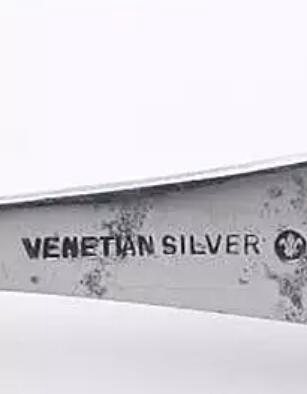
Treble Plate
Treble plate is another deceptive silver alloy that has marks and looks authentic. The term “Treble plate” means three pieces of silver alloys were added to another base metal.
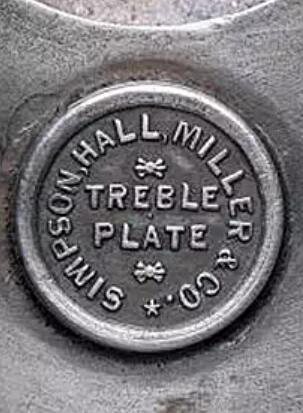
What To Avoid When Identifying Silver Markings
Following the guide in this article makes it easy to identify silver markings on a silver plate, but you could fall for some tricks by con artists if you aren’t vigilant enough.
Sometimes, they could come in the form of totally false markings designed to look like the original. On the other hand, the marks may not be false but written and presented in a way that makes them look like they are worth more.
For example, you may see “silver soldered” or “sterling inlaid” on a piece and think it is sterling silver.
As explained above, a sterling inlaid is just a piece of metal with a silver plate over the body. This silver-plated metal can be confusing if you don’t have any experience identifying silver markings.
Pieces with “silver soldered” written on them are often used to represent metals that were soldered or joined together with silver solder. Silver is a good material for high-temperature welding projects and is often used for that purpose.
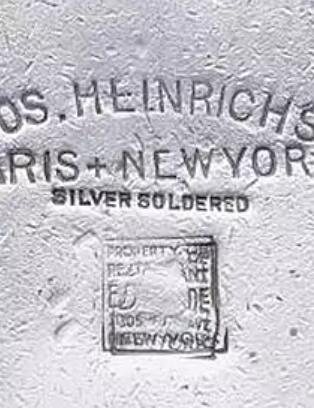
An easy way to avoid making mistakes when identifying silver markings is by asking experts for help. There are many online forums where you can ask for advice before buying or selling a silver piece. You can snap the marks on your piece and send it to the forum for feedback.
You can also study online guides and tables to learn more about the different marks you find on silver antiques you own.
What Is Your Antique Silver Worth?
The worth of your antique silver depends on many factors listed throughout this guide.
If your silver piece is sterling, it would be worth more than if it is just a silver plate (which should be worth almost nothing).
Investing in Sterling Silver
Sterling silver is an important commodity to invest in, just like gold. Silver, like gold, appreciated in value through the rough years of the financial crisis (2007 – 2009). You can invest in silver bullions or mining stocks if you want to.
Like other investments your profits are not guaranteed.
How to Buy or Sell Your Silver Piece
You can buy and sell your silver antiques, flatware, and jewelry in several ways. Let’s go through three of them:
Coin Shop
You can just walk into a coin shop and get a price. Then, if the price is okay, you can agree to sell. You can also buy from a jeweler this way.
Smelter
A smelter will value your silver piece solely on its silver content, not the rarity or the marks and patterns. This is much better than jewelers and coin shops, but they usually require large amounts of silver, not small pieces owned by individuals.
Roadshow Dealers
Roadshow dealers come to towns occasionally to look for unique antiques like fine art worth lots of money, silver flatware, or jewelry. These ones try to buy as cheap as possible to cover the cost of coming to your town, security, etc.
Roadshow dealers are not the best option if you want the best from your marked silver piece.
Silver Matching Services
Silver matching services are online services that check the amount of silver on a piece, the marks on the piece, the date letters, the duty mark, and all other essential details on the piece and offer an amount based on that.
You will make more from silver matching services than all the others on this list. This is because silver matching services have experienced experts accurately quantifying the value of marked silver antiques.
Bottom Line
You have learned how to read silver hallmarks and identify American silver marks and other important marks on different silver antiques. You have also learned that these hallmarks are the reason some silver antiques are more valuable than others.
Also, it is essential to remember that other kinds of silver hallmarks show that metal pieces are not authentic. For example, silver solder, Venetian silver, sterling in-laid, etc., are not real silver. Instead, they are primarily silver-plated metals.
Remember that your flatware or jewelry is only worth as much as you know about it. Many people will try to con you with fake hallmarks to get your money.
Thankfully, you have read this guide, and if you have further questions, there are online forums you can use to make inquiries about your silver piece to make better-informed decisions.





![Where To Sell Antique Furniture In 2022 [Ultimate Guide]](https://www.jacquelinestallone.com/wp-content/uploads/2022/09/Etsy-Your-Place-To-Buy-And-Sell-All-Things-Handmade-600x450.jpg)


